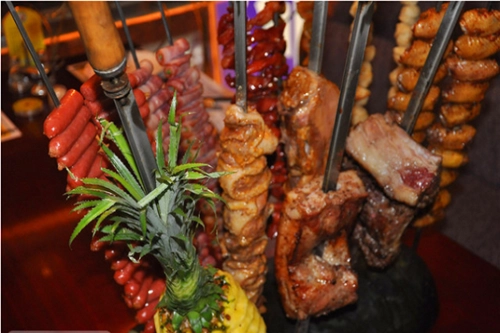
Brazilian cuisine is a vibrant blend of influences from its indigenous, European, and African roots, as well as regional variations across the country. Here are some famous Brazilian dishes:
- Feijoada: Considered Brazil’s national dish, feijoada is a hearty stew made with black beans, various cuts of pork (such as ribs, sausages, and salted pork), and sometimes beef. It is traditionally served with rice, collard greens, farofa (toasted cassava flour), and orange slices to aid digestion.
- Moqueca: A flavorful seafood stew originating from the coastal regions of Bahia and Espírito Santo. Moqueca is made with fish or shrimp, tomatoes, onions, garlic, coriander, and coconut milk, then slowly cooked in a traditional clay pot. In Bahia, the dish often includes palm oil (dendê), giving it a distinct flavor and color.
- Churrasco: Brazilian barbecue, known as churrasco, is famous for its various cuts of seasoned, skewered meats, including beef, pork, chicken, and sausages. The meats are grilled over an open flame and often served with chimichurri sauce or farofa on the side.
- Coxinha: A popular Brazilian street food and snack, coxinha is a deep-fried, teardrop-shaped croquette filled with shredded chicken and sometimes cream cheese. The filling is encased in a dough made from wheat flour and chicken broth, which is then breaded and fried until crispy.
- Pão de queijo: These cheese bread rolls are a beloved Brazilian snack made from cassava (tapioca) flour, cheese, eggs, and milk. Pão de queijo is naturally gluten-free and has a unique chewy texture that is both soft and slightly crunchy.
- Brigadeiro: A popular Brazilian dessert, brigadeiro is a small, chocolatey, fudge-like treat made from sweetened condensed milk, cocoa powder, and butter, then rolled in chocolate sprinkles. They are often served at parties and special occasions.
- Acarajé: A traditional Afro-Brazilian street food from the state of Bahia, acarajé is a deep-fried fritter made from peeled black-eyed peas, onions, and ground shrimp. It is typically split in half and filled with vatapá (a spicy paste made from shrimp, coconut milk, and bread), caruru (an okra-based stew), and other accompaniments like tomato salad and shrimp.
- Bobó de camarão: A rich and creamy shrimp dish from Bahia, bobó de camarão combines shrimp with a puree of cassava (manioc), coconut milk, tomatoes, onions, and various seasonings. It is often served with rice or farofa.
- Canjica: A traditional Brazilian dessert, canjica is a sweet, creamy, corn-based pudding made from hominy corn, milk, sweetened condensed milk, sugar, cinnamon, and cloves. It is often served during the Brazilian winter festival, Festa Junina.
These dishes showcase the diverse flavors and culinary traditions of Brazilian cuisine, reflecting the country’s rich cultural history and regional influences.
- Pastel: A popular Brazilian street food, pastel is a deep-fried pastry typically filled with various ingredients such as ground beef, cheese, chicken, shrimp, or hearts of palm. The dough is thin and crispy, and the pastel is often enjoyed with a squeeze of lime or a dash of hot sauce.
- Açaí: Açaí is a fruit native to the Amazon rainforest, and it has become a trendy superfood worldwide due to its high antioxidant content. In Brazil, açaí is traditionally served as a frozen pulp, often sweetened with sugar or honey and topped with granola, bananas, or other fruits. It is consumed as a refreshing snack or meal, especially in the hot summer months.
- Farofa: A common side dish in Brazilian cuisine, farofa is made from toasted cassava flour mixed with various ingredients such as bacon, sausage, onions, garlic, eggs, and herbs. It adds a crunchy texture to dishes like feijoada, churrasco, or rice and beans, and is often used as a condiment or garnish.
- Quindim: A bright yellow dessert with a glossy surface, quindim is made from egg yolks, sugar, butter, and grated coconut. It has a rich, custard-like consistency and is baked in individual molds, resulting in a slightly caramelized exterior.
- Cuscuz paulista: Originating from the São Paulo region, cuscuz paulista is a savory molded dish made from cornmeal, tomato sauce, vegetables, and various proteins like shrimp, sardines, or chicken. It is cooked in a special steamer called a cuscuzeira and is often served as a side dish or appetizer.
These additional Brazilian dishes demonstrate the wide range of flavors, ingredients, and cooking techniques found in the country’s cuisine. From street food to regional specialties, Brazilian food offers a delicious culinary adventure for those looking to explore its rich culture and traditions.